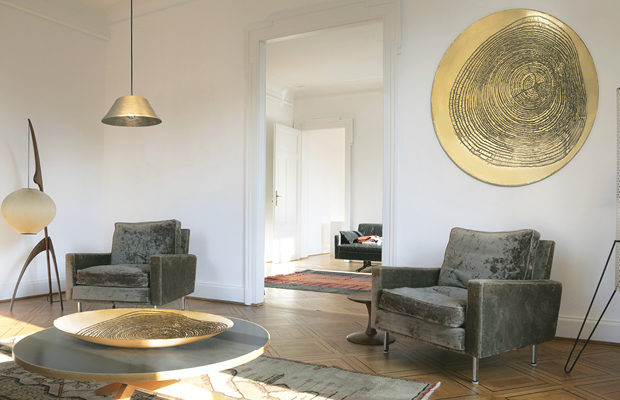 KENEK PHOTOGRAPHY/COURTESY WEXLER GALLERY
KENEK PHOTOGRAPHY/COURTESY WEXLER GALLERY
Design
Trunk Show
ISRAELI DESIGNER SHARON SIDES, best known for her brass Stumps chairs, has been fascinated by metals since childhood. “I used to visit my father’s aluminum fabrication factory in Tel Aviv and watch him create something out of nothing,” she says. That experience, enhanced by an array of creative college courses, influenced Sides to leave her job with Berlitz and choose to study industrial design at Jerusalem’s Bezalel Academy of Art and Design. The four-year program at Bezalel turned out to be tougher than expected: “We often worked from 8 a.m. to midnight or 1 a.m. on projects but I learned to use many materials and designed everything from toys to furniture,” she recalls.
That rigorous training helped Sides hone her craft as she mastered the elements of what Bezalel calls “the professional hard-core of traditional product design” in synergy with more experimental, conceptual, and creative design objectives. Nowadays Sides is as comfortable with metalworking machinery as she is with computers, and fabricates her own creations. “Without question, she understands materials and using them,” says Lewis Wexler, co-owner of the Wexler Gallery in Philadelphia, which represents Sides. “Her industrial design background adds value in creating something both decorative and functional.”
In her student days, an exchange program enabled Sides to spend a semester at Pratt Institute in Brooklyn. “New York was amazing but I was surprised to find that my training at Bezalel was more intense,” she says. However, she was delighted with the greater choice of equipment available at Pratt. “They had the latest 3-D printers, laser cutting machines, and more. It was a great opportunity to learn and experience the newest techniques.”
Returning to Bezalel, she had the opportunity to study with Ezri Tarazi, a leading industrial designer in Israel. (She continued as his studio manager for four years following graduation, and says she learned everything from product design details to managing production and exhibiting worldwide there.) Then, another professor’s challenge set Sides on a new trajectory. “He suggested we move away from planned projects to ‘a project you cannot control,’” she recalls. She saw it as an opportunity to harness her growing appreciation for nature with the imperatives of industrial design. Already enthralled by the effect of different acids on metal, she was particularly drawn to copper. “I fell in love with the blues and green in the copper and iron oxidation process,” she explains.
For a year she experimented with designs on her computer, digitally transferring specific patterns for etching onto metal. She tried images of handwriting and newsprint followed by natural designs of leaves, flowers, and hundreds of animal skins. Finally, the “aha!” moment happened—creating designs using cross sections of tree trunks. “I found tree rings tell an amazing story, especially the age of the tree. It’s like reading a palm and every tree is different.”
The three original Stumps chairs, their brass backs and seats acid-etched with tree rings, formed her graduation portfolio. Displayed in the graduation exhibition, they launched her career when a visitor from the U.S. bought one. Sides says it was a transformative moment: “It wasn’t about money but that someone appreciated the work and wanted a hand-made piece in his home. That’s when I understood that design was for people, not to make the teacher happy!”
Publicity and internet exposure ensued, and Sides started to sell her work. She continues to make the Stumps chairs (now also known as Flor chairs) and fabricates a range of other objects based on the fluid curves of etched metal sheets. She converts perfect rounds into hanging lights, and the tree rings also appear in shapely bowls and wall hangings that evoke ancient bronze shields.
Starting in a casting workshop in southern Tel Aviv and later in Jerusalem, she is completely involved in the lengthy and meticulous process of producing her designs. She spends hours on the computer creating detailed images that are printed on special paper and then transferred to metal sheets that are immersed in an acid bath for periods ranging from two hours to two days. The etched metal is shaped, sanded, and hand-finished to create the final piece. The technique allows natural oxidation to subtly change the material over time, adding character to each piece, while the outline and grain of the tree trunk stay intact.
For a (now sold-out) limited edition of twelve Flor chairs for Wexler Gallery, she sand-cast branches in bronze to form the legs. She also uses the spindly cast branches on limited-edition coffee tables.
Currently Sides is experimenting with snakeskin designs, working on renderings for a new chair series for Wexler Gallery and for chairs for a New York hotel. The common denominator of her designs, which can be custommade, is that all are inspired by nature. But Sides is adamant about one thing: “I will not kill a tree for my work.”











